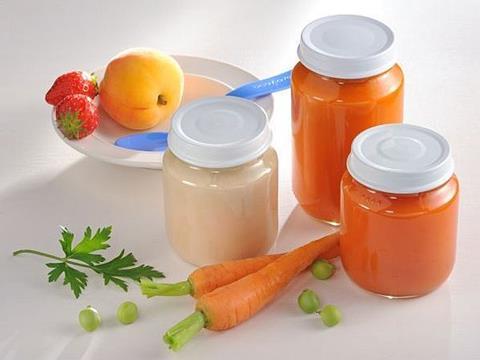
The manufacture of baby food not only places high demands on producers and farmers but also on the quality and experience of a laboratory service-provider. The legislator also regards babies and infants as a section of the population which requires particular protection as the ingestion-to-bodyweight ratio is never as high during any other stage of life.
Not only during the cultivation and manufacture of the corresponding foodstuffs is it therefore necessary to be vigilant about possible contaminants and the elimination thereof; the diet regulation also provides detailed specifications on nutrient and vitamin content, with confirmation of observance thereof requiring precise scientific measurements.
Dr. Ulrich Nehring, a food technologist and former head of Nehring Institute (now owned by Eurofins), explores challenges and solutions when it comes to packing sensitive baby food in this Q&A.
Dr. Nehring, as as a food technologistyou were preoccupied with analyzing complex food matrices. What in particular is examined in baby and infant food?
When testing food for babies or infants, consideration is primarily given to health aspects as babies and infants are more sensitive than other consumers and their health therefore requires particular protection. Biological, chemical and physical contaminants as well as the content of essential nutrients are of particular significance for food safety for babies and infants. Biological contaminants primarily involve microorganisms such as listeria or salmonella which are pathogenic, i.e. harmful to health. Chemical food contaminations can have a wide variety of origins. These primarily involve residue of pesticides and veterinary medicinal products, heavy metals or environmental chemicals such as dioxins. But tests are also conducted for harmful substances prevailing in nature, e.g. solanine and chaconine, which can be found in potato products, or mycotoxins which are formed from mold, e.g. in the cultivation or storage of grains. The contaminants examined in food for babies and infants also include substances which can migrate from packaging into food, e.g. printing ink components or certain plasticizers.

Some of the content levels for vital nutrients for baby and infant food are legally specified by an EU regulation. In any case, the contents of essential nutrients must be indicated on the packaging. Tests are therefore conducted regularly to examine whether the statutory limits for calorific value, protein, sugar, fat, minerals, and vitamins correspond with specifications.
But pesticides, heavy metals, mycotoxins and other substances are not only capable of entering food during cultivation and manufacturing. As early as the mid-90s, the public was alarmed by the detection of PVC plasticizers in infant food. Back then, the Federal Institute for Risk Assessment – BfR – demanded both intensive tests regarding the sources and general minimization of contamination with phthalic acid esters for reasons of preventive health protection.
What sources are possible for the detection of PVC plasticizers in baby food?
Polyvinyl chloride (PVC) is a popular plastic which has excellent technical properties for many applications. If items made of PVC need to be flexible, this can only be achieved by using plasticizers. Accordingly, sources for plasticizers in baby food can be any item made of plasticized PVC which comes into contact with food or its ingredients. Apart from plant components such as tubes or conveyor belts, this can even be the seals in jar closures for baby food in glass packaging. These seals are usually manufactured from plasticized and foamed PVC in order to guarantee tight jar closures, thereby protecting food from spoilage by microorganisms and atmospheric oxygen.
How can these plasticizers enter food?
Plasticizers are evenly distributed in the PVC of the sealing compounds for jar closures but they are not chemically bonded with the plastic. The PVC seals in jar closures comprise 30 to 50% plasticizers. If food components migrate into the sealing compound – which inevitably happens when food comes into contact with the seal – the plasticizers can dissolve in part from the sealing compound and migrate into food. Because all PVC plasticizers are particularly soluble in fat, fatty foods especially are affected by such plasticizer migration. In low-fat foodstuffs, migration by plasticizers is only discernible to a very low extent or not at all. Migration by plasticizers occurs faster at higher temperatures and does not diminish during the storage of packaged food, i.e. the longer food has been stored in glass packaging, the greater the concentration of plasticizers in the food.
What possibilities are there for avoiding such contamination?
Since it has transpired that plasticizers can migrate in relatively high quantities into fatty foods, there has been an attempt to find technical solutions for this problem. On the one hand, plasticizers harmful to health have been banned for use in contact with baby and infant food. On the other hand, new plasticizers have been developed whose chemical properties make it more difficult for them to leach from the PVC and migrate into food. Such plasticizers are widely in use today. An entirely different alternative is presented by sealing compounds for glass closures which are not manufactured from PVC and therefore do not contain any plasticizers at all. Such sealing compounds are usually manufactured from thermoplastic elastomers (TPE). PROVALIN® was developed for this purpose at a very early stage and has been continuously improved on the basis of extensive practical experience. Theoretically, it is also possible to envisage replacing glass packaging for baby food, e.g. using sealed plastic pouches. But this alternative has not managed to assert itself on account of the outstanding characteristics of glass packaging with screw caps.
In its statement 010/2005 in 2005 on the topic of “Migration of plasticizers from screw-cap sealing compounds into food”, the BfR made an urgent recommendation to industry – which is responsible for the health safety of its products within the framework of the Foodstuffs and Consumer Goods Law (LMBG) – to dispense with the use of phthalates in sealing compounds for lids. This essentially concerned fatty foods.
Why fatty foods in particular? And should it not apply for all food, especially where baby and infant food is concerned?
First of all, it must be noted regarding the legal situation that the responsible legislator, i.e. the EU Commission, issued extensive restrictions back in 2007 by means of an amendment of Directive 2002/72/EC on the use of various plasticizers in materials and items made of plastic coming into contact with food. This legislation overrides the BfR statement 010/2005. Accordingly, a range of phthalic acid esters (phthalates) may only be used as plasticizers in single-use materials and items with food contact if there is no contact with fatty foods. Contact with baby and infant food is not permissible. Similar restrictions also apply for other plasticizers such as epoxidized soybean oil (ESBO).
These restrictions focus on fatty foods because plasticizers are fat-soluble and therefore migrate heavily into fatty foods, while barely any migration by plasticizers is established for low-fat or fat-free foods.
Babies and infants are particularly sensitive consumer groups whose health requires particular protection. Babies and infants have comparably low body weights and their diets are frequently based on less diverse food. It makes sense, therefore, to make a special regulation for this consumer group concerning the use of certain plasticizers. For older consumer groups, such as children from the age of 3, adolescents or adults, the current state of knowledge implies that the plasticizers in question do not pose a health risk when the materials and items do not come into contact with fatty foods.
In the form of PROVALIN®, a PVC-free sealing compound has already been available for several years for metal vacuum closures. You and your institute were also responsible for the corresponding inspections and migration tests. What was tested? What were the results? And what can you personally tell about PROVALIN®?
The PVC-free sealing compound PROVALIN® was tested for its food-safety conformity and health safety. To this aim, the material formula was first tested on the basis of the base materials used. The migration of substances from the sealing compound into food was examined extensively in simulation tests. So-called global migration with various food simulants was determined and the specific migration of certain substances governed by statutory restrictions examined. The extent to which the sealing compound has an influence on the sensory characteristics of food, i.e. flavor, odor, and appearance, was also examined. And we examined whether and to what extent many unanticipated substances can migrate from the sealing compound into food.
As a result, we were able to fully confirm the food-safety conformity and health safety of PROVALIN®.
Baby food is essentially offered in glass jars with press-on twist off caps, for which the PVC-free sealing compound has also been available since last year, thereby finally representing a solution for this area. Why, in your opinion, is that important, even if this area has less to do with oily foods?
P/T caps are very popular for packaging baby food in jars in particular. A PVC-free sealing compound for this special type of jar closure enables manufacturers of baby food to offer the corresponding products to consumers wishing to dispense with PVC and plasticizers in their packaging materials.
Some baby food has a considerable fat content. Furthermore, the packaging sizes for products packaged in jars are rather small which means that a relatively high volume of packaging material comes into contact with relatively small volumes of food. As a consequence, the concentration of migrating substances in baby food is higher than in larger packaging volumes.
What would you recommend manufacturers, distributors and purchasers of baby food?
Manufacturers of baby food need to consider which seal solution is the best option for the respective product. Apart from matters concerning conformity and food safety, it also goes without saying that such considerations need to take account of the technical properties of seals, their ecological compatibility, and product acceptance by consumers. A closure solution should only be used and marketed once it meets the requirements in all areas. In the form of the P/T closures featuring the PROVALIN® PVC-free sealing compound, entirely new possibilities are now available for manufacturers of baby food.
Distributors of baby food (retailers, wholesalers) should also consider and objectively weigh up the aspects outlined above when making decisions in favor of a certain packaging solution. A decision made exclusively on the basis of consumer acceptance or reports in the mass media, for example, does not usually take full account of the complexity of the issue concerning the best packaging solution and can lead to significant problems with individual products.
But consumers should also attempt to make decisions concerning products on a supermarket shelf in a manner which is as objective and fact-based as possible; this applies in particular for products intended for consumption by our children.
For baby food in glass packaging, P/T closures with PVC-free sealing compounds made from thermoplastic elastomers are a good and safe alternative to P/T closures with conventional sealing compounds made from plasticized PVC.




















